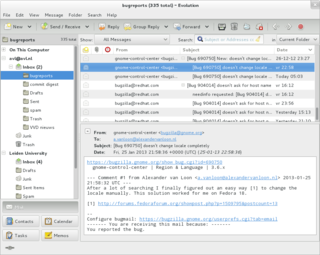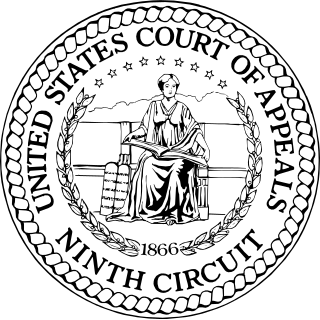Related Research Articles

Electronic mail is a method of exchanging messages ("mail") between people using electronic devices. Email entered limited use in the 1960s, but users could only send to users of the same computer. Some systems also supported a form of instant messaging, where sender and receiver needed to be online simultaneously. Ray Tomlinson is credited as the inventor of networked email; in 1971, he developed the first system able to send mail between users on different hosts across the ARPANET, using the @ sign to link the user name with a destination server. By the mid-1970s, this was the form recognized as email. Email describes the overall method and "an email" is a message in the system.

Spamming is the use of messaging systems to send multiple unsolicited messages (spam) to large numbers of recipients for the purpose of commercial advertising, for the purpose of non-commercial proselytizing, for any prohibited purpose, or simply sending the same message over and over to the same user. While the most widely recognized form of spam is email spam, the term is applied to similar abuses in other media: instant messaging spam, Usenet newsgroup spam, Web search engine spam, spam in blogs, wiki spam, online classified ads spam, mobile phone messaging spam, Internet forum spam, junk fax transmissions, social spam, spam mobile apps, television advertising and file sharing spam. It is named after Spam, a luncheon meat, by way of a Monty Python sketch about a restaurant that has Spam in almost every dish in which vikings annoyingly sing "Spam" repeatedly.
Various anti-spam techniques are used to prevent email spam.

The Controlling the Assault of Non-Solicited Pornography And Marketing (CAN-SPAM) Act of 2003 is a law passed in 2003 establishing the United States' first national standards for the sending of commercial e-mail. The law requires the Federal Trade Commission (FTC) to enforce its provisions. Introduced by Republican Conrad Burns, the act passed both the House and Senate during the 108th United States Congress and was signed into law by President George W. Bush in December of 2003.

Email spam, also referred to as junk email or simply spam, is unsolicited messages sent in bulk by email (spamming).
Sender Policy Framework (SPF) is an email authentication method designed to detect forging sender addresses during the delivery of the email. SPF alone, though, is limited to detecting a forged sender claim in the envelope of the email, which is used when the mail gets bounced. Only in combination with DMARC can it be used to detect the forging of the visible sender in emails, a technique often used in phishing and email spam.
A joe job is a spamming technique that sends out unsolicited e-mails using spoofed sender data. Early joe jobs aimed at tarnishing the reputation of the apparent sender or inducing the recipients to take action against them, but they are now typically used by commercial spammers to conceal the true origin of their messages and to trick recipients into opening emails apparently coming from a trusted source.
Greylisting is a method of defending e-mail users against spam. A mail transfer agent (MTA) using greylisting will "temporarily reject" any email from a sender it does not recognize. If the mail is legitimate, the originating server will try again after a delay, and if sufficient time has elapsed, the email will be accepted.
A bounce message or just "bounce" is an automated message from an email system, informing the sender of a previous message that the message has not been delivered. The original message is said to have "bounced".
Email marketing is the act of sending a commercial message, typically to a group of people, using email. In its broadest sense, every email sent to a potential or current customer could be considered email marketing. It involves using email to send advertisements, request business, or solicit sales or donations. Email marketing strategies commonly seek to achieve one or more of three primary objectives, to build loyalty, trust, or brand awareness. The term usually refers to sending email messages with the purpose of enhancing a merchant's relationship with current or previous customers, encouraging customer loyalty and repeat business, acquiring new customers or convincing current customers to purchase something immediately, and sharing third-party ads.
Email authentication, or validation, is a collection of techniques aimed at providing verifiable information about the origin of email messages by validating the domain ownership of any message transfer agents (MTA) who participated in transferring and possibly modifying a message.

Email spoofing is the creation of email messages with a forged sender address.
A challenge–response system is a type of spam filter that automatically sends a reply with a challenge to the (alleged) sender of an incoming e-mail. It was originally designed in 1997 by Stan Weatherby, and was called Email Verification. In this reply, the purported sender is asked to perform some action to assure delivery of the original message, which would otherwise not be delivered. The action to perform typically takes relatively little effort to do once, but great effort to perform in large numbers. This effectively filters out spammers. Challenge–response systems only need to send challenges to unknown senders. Senders that have previously performed the challenging action, or who have previously been sent e-mail(s) to, would be automatically whitelisted.
DomainKeys Identified Mail (DKIM) is an email authentication method designed to detect forged sender addresses in email, a technique often used in phishing and email spam.
Email forwarding generically refers to the operation of re-sending an email message delivered to one email address to one or more different email addresses.

CompuServe Inc. v. Cyber Promotions, Inc. was a ruling by the United States District Court for the Southern District of Ohio in 1997 that set an early precedent for granting online service providers the right to prevent commercial enterprises from sending unsolicited email advertising - also known as spam - to its subscribers. It was one of the first cases to apply United States tort law to restrict spamming on computer networks. The court held that Cyber Promotions' intentional use of CompuServe's proprietary servers to send unsolicited email was an actionable trespass to chattels and granted a preliminary injunction preventing the spammer from sending unsolicited advertisements to any email address maintained by CompuServe.

Gordon v. Virtumundo, Inc., 575 F.3d 1040, is a 2009 court opinion in which the United States Court of Appeals for the Ninth Circuit addressed the standing requirements necessary for private plaintiffs to bring suit under the Controlling the Assault of Non-Solicited Pornography and Marketing Act of 2003, or CAN-SPAM Act of 2003, 15 U.S.C. ch. 103, as well as the scope of the CAN-SPAM Act's federal preemption. Prior to this case, the CAN-SPAM Act's standing requirements had not been addressed at the Court of Appeals level, and only the Fourth Circuit had addressed the CAN-SPAM Act's preemptive scope.
A web beacon is a technique used on web pages and email to unobtrusively allow checking that a user has accessed some content. Web beacons are typically used by third parties to monitor the activity of users at a website for the purpose of web analytics or page tagging. They can also be used for email tracking. When implemented using JavaScript, they may be called JavaScript tags.

Omega World Travel, Inc. v. Mummagraphics, Inc., 469 F.3d 348, is a case in the United States Court of Appeals for the Fourth Circuit in which Mummagraphics, Inc. is sued by Omega World Travel, Inc. (Omega) and Cruise.com after Mummagraphic alleged that they received 11 commercial e-mail messages in violation of the Controlling the Assault of Non-Solicited Pornography and Marketing (CAN-SPAM) Act of 2003 as well as Oklahoma state law. In the initial filing, the United States District Court for the Eastern District of Virginia had awarded summary judgment to Omega on all of Mummagraphics' claims finding that the commercial emails from Omega did not violate the CAN-SPAM Act, and that the CAN-SPAM Act preempted Oklahoma state law. The Court of Appeals affirmed.
A cold email is an unsolicited e-mail that is sent to a receiver without prior contact. It could also be defined as the email equivalent of cold calling. Cold emailing is a subset of email marketing and differs from transactional and warm emailing.
References
- 1 2 3 4 5 6 7 8 9 10 11 12 13 14 Kleffman v. Vonage Holdings Corp. , 232 P.3d 625 (Cal. 2010).
- ↑ Kleffman v. Vonage Holdings Corp., 2007 WL 1518650 (C.D. Cal. May 23, 2007).
- ↑ Kleffman v. Vonage Holdings Corp., 551 F.3d 847 (9th Cir. 2008).
- ↑ Spam laws around the world (COMPUTERWORLD) Archived January 14, 2010, at the Wayback Machine
- ↑ Spammers Sneak Through CAN-SPAM Loopholes (PCWorld)